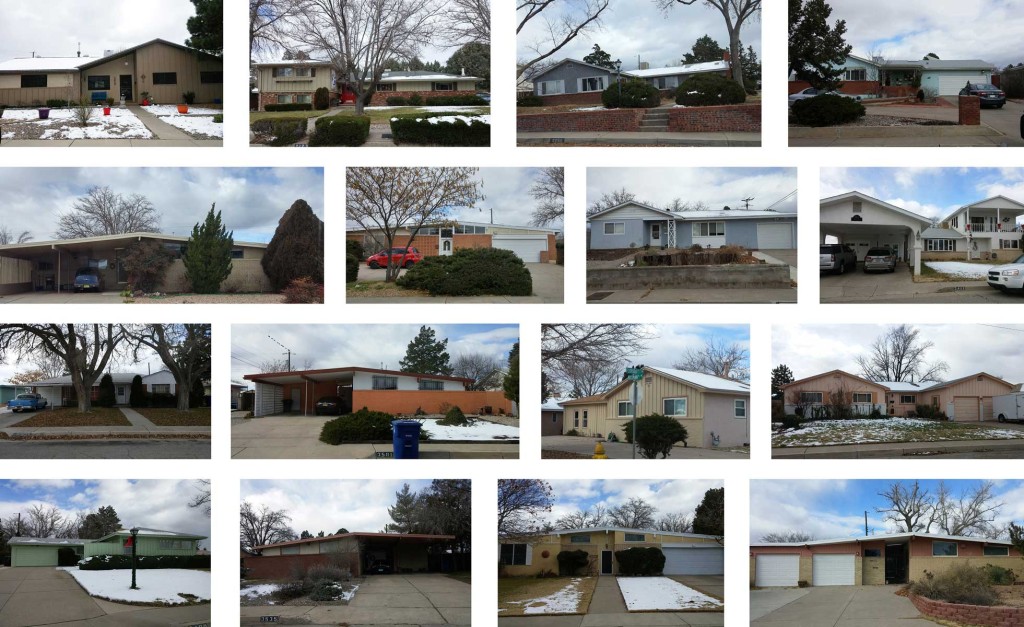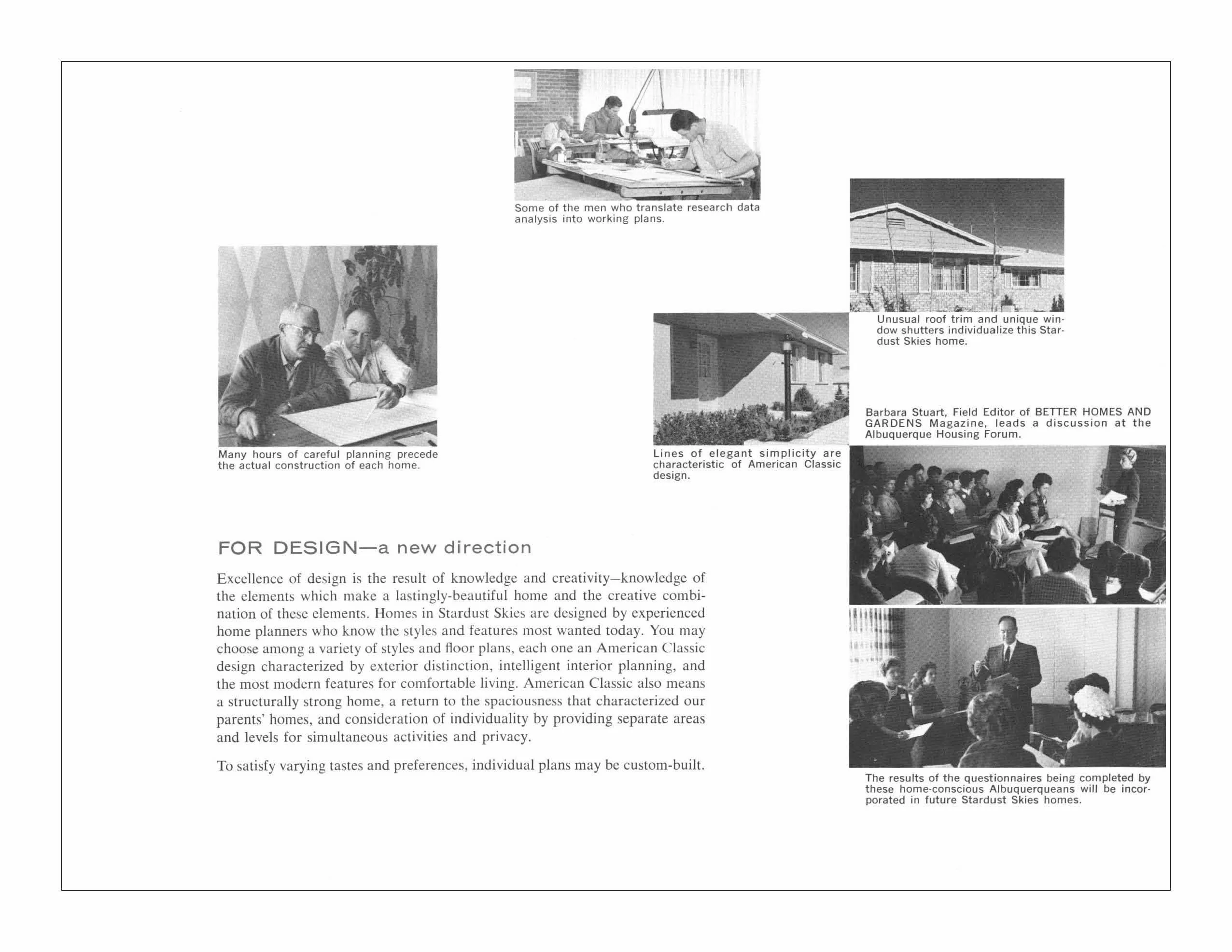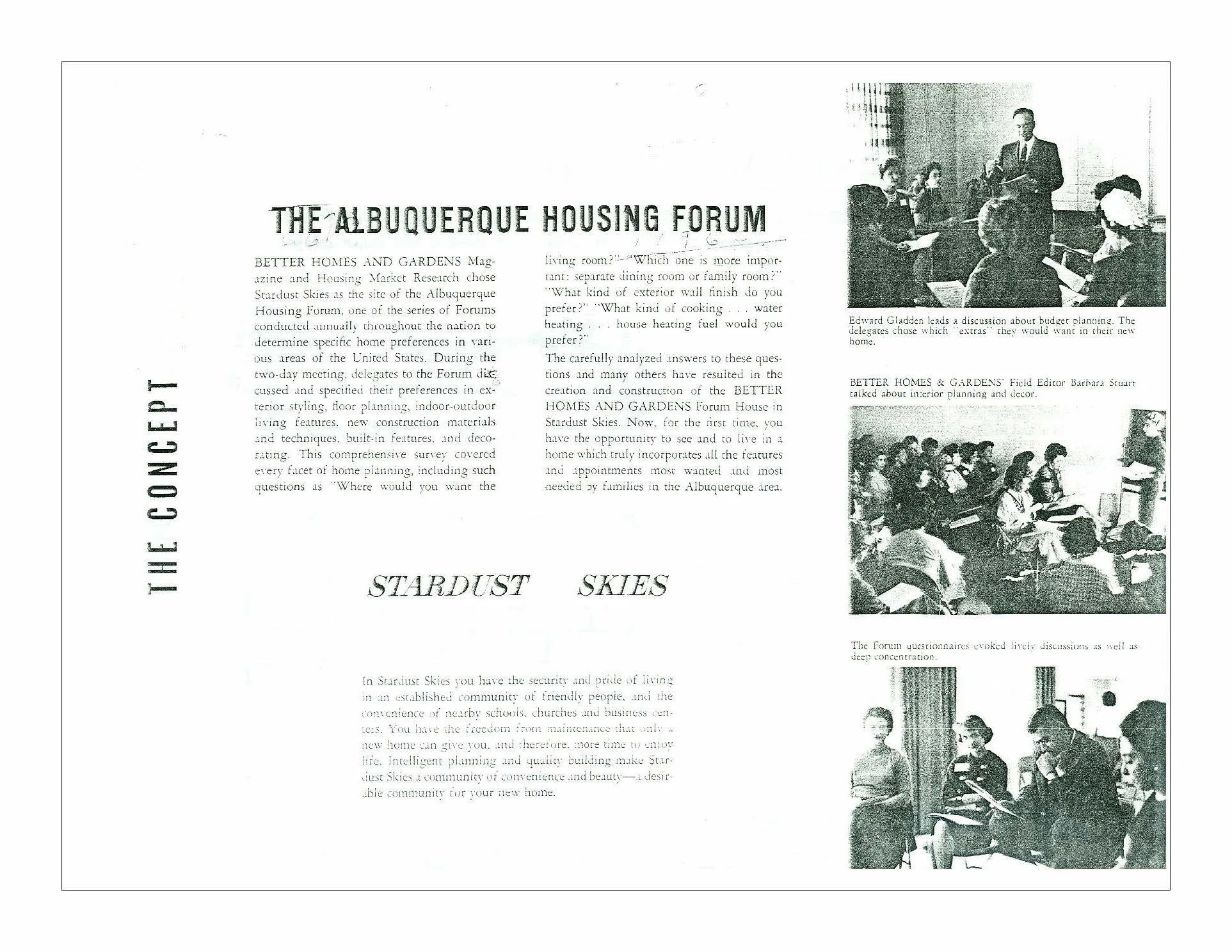1940s-1980s
Mossman-Gladden, Inc.
Case study by:
Cameron Townsend,Fri Oct 09 2015
Mossman-Gladden Homes

Introduction
When shopping for a home in Albuquerque, buyers may hear the phrase, “It’s a Mossman,” spoken proudly by a realtor or seller. This phrase does not refer to a particular style; rather, it refers to the builder. Mossman-Gladden, a construction company founded by Fred A. Mossman in the late 1940s, built over 7,500 homes in Albuquerque’s Northeast Heights, earning a reputation for quality craftsmanship and lasting value.1 The company continued to build homes into the early 1980s. Mossman-Gladden-constructed homes were no doubt part of Albuquerque’s dramatic post-war housing boom, but they also reflect the attitudes of the following decades they spanned during the height of the Cold War.
Beginning right before World War II, Albuquerque received bountiful defense funding and an influx of people arrived with it. In fact, Albuquerque experienced such rapid growth that its population grew by more than five times between 1940 and 1970.2 This boom especially accelerated after the war’s completion, a phenomenon that was also true for much of the rest of the nation. Following World War II, cities all over America experienced dramatic population growth as soldiers returned home and started families. Those families needed homes, and soon a housing shortage followed.
Entrepreneurial builders saw opportunity in this housing shortage and responded with a new, mass-production approach to residential construction. Instead of building houses one at a time, with each house individually designed, they bought large tracts of undeveloped land and offered a limited variety of floor plans. Buyers could then choose a floor plan and purchase a brand-new house in a brand-new neighborhood, specifically built for them. With the help of FHA- and VA-backed loans and affordable, rapid transportation in the form of the automobile, large masses of young families bought up these mass-produced homes. In booming Albuquerque, most of these new developments sprang up north and east of downtown, in what became known as the Northeast Heights.
A handful of builders were largely responsible for the development of the Northeast Heights: Dale Bellamah, Sam Hoffman, Fred Mossman, and Ed Snow.3 Of these, Mossman-Gladden was perhaps the most well known and highly regarded. Fred A. Mossman was born in 1906 in North Dakota and only received an 8th grade education before beginning a career in carpentry.4 Like many other migrants to the region, he and his wife Edna came to Albuquerque in 1937 because of Edna’s tuberculosis. After her passing, Mossman remarried. With the help of his new wife, Mary, he founded a construction company. In 1948, Mossman’s son-in-law, Edward Gladden, joined him, and the company became Mossman-Gladden. Gladden oversaw administrative tasks like permitting and sales, while Mossman continued his hands-on management of the construction side.5
Neighborhood Standardization
From the late 1940s to the early 1980s, Mossman-Gladden built over 7500 homes in Albuquerque, primarily in four neighborhoods bounded by Candelaria Road NE to the south, San Antonio Drive NE to the north, San Mateo Boulevard NE to the west, and Wyoming Boulevard NE to the east.6 The names of these neighborhoods are Altamont, Stardust Skies, Highlands North, and Bear Canyon.7 Mossman-Gladden constructed Altamont, the first and largest of these developments, in the late 1950s and early 1960s south of Montgomery Boulevard NE between San Mateo and Louisiana Boulevards NE. Altamont set the pattern for the other Mossman-Gladden neighborhoods that followed, with winding, tree-lined streets and convenient proximity to amenities like parks, schools, and shopping malls.8
Mossman-Gladden kept with the era’s general practice of residential standardization, but also placed an emphasis on the availability of optional features and customization, experimented with contemporary forms, and appealed to a more affluent consumer than many of their peers. Brochures for Altamont highlighted features such as indoor-outdoor living spaces, hardwood floors, and large lot sizes. The floor plans sprawled out horizontally and had an open concept, which allowed for plenty of daylight throughout the homes. These elements combined to create strong modernist designs that stood out from other mass-produced options available at the time and suggested that the builders were interested in national trends. Indeed, at their first development, the builders advertised 14 exterior options and showed models named after locations across the country and beyond. While a couple of models, like the Pala Verde and the Taos, alluded to a New Mexican heritage, most of the others, like the Londonaire, the Baltimore, and the New York, implied a more upscale styling and a broader geographic view.
This tactic was used in their later developments as well and suggests the type of buyers that Mossman-Gladden was trying to attract: the influx of scientists, military officials, and other newly arrived professionals who continued to pour into Albuquerque from WWII into the Cold War. These buyers and their families represented a higher-than-average income segment, which the prices of the homes in Altamont reflected. For example, average models had three bedrooms and were roughly 1,900 square feet, with a price around $20,000.9 By comparison, in Dale Bellamah’s Princess Jeanne Park, a competing development, an average home with three bedrooms cost $9,000 and appeared to target the “every man.”10 Mossman-Gladden was clearly targeting a different class of homebuyers.
These approaches continued in Stardust Skies, the next neighborhood Mossman-Gladden completed, which they built during the late 1960s and early 1970s. The development lies directly east across Louisiana Boulevard from Altamont. It offered the same convenience and community planning features as its predecessor, but the homes were generally a little larger. Average homes here had three or four bedrooms, roughly 2,100 square feet, and a price around $26,500, which was approximately the same as Altamont homes when adjusted for inflation.11 Advertisement brochures explained the neighborhood as a culmination of “intelligent planning, research analysis, excellent design, quality materials, expert workmanship and a location of beauty and convenience.” They stressed that the houses were beautiful, comfortable, and livable, and that a great amount of forethought was put into home and community planning. One brochure advertised that Mossman-Gladden was “rising to meet the challenge of today’s more knowledgeable and more particular home-buyers,” again making clear that the builder was distinguishing itself as a provider of more than just affordable homes for the average man. They were seeking the “more particular” among new arrivals.12
Highlands North and Bear Canyon followed in the 1970s and early 1980s. The brochures for the two developments continued to place special importance on the quality and care that distinguished Mossman-Gladden’s reputation by this point. Earlier advertisements had alluded to the scientific process of design and construction used by the builder, but the brochures for Highland North began to put a much larger emphasis on that aspect. One tagline read, “Knowledge is the key to successful home building.” The words “intelligent” and “expert” recurred repeatedly. Despite these continuities, evolving trends were also evident in the brochure for Bear Canyon, which called the models “townhouses” and referred to the options only by numbers, no longer names, perhaps suggesting that the builder no longer needed to appeal to arrivals from elsewhere to sell homes.13 Nonetheless, these remained above average houses in the still-growing suburbs. Highland North’s homes had an average of three to four bedrooms, 2,000 square feet, and a price of $30,000. A 1980s-era brochure for Bear Canyon shows two sample homes with prices of $46,000 and $96,000.14 While this may sound dramatically higher, $96,000 in 1984 translates to roughly $29,100 in 1965 when adjusted for inflation, suggesting that the builder remained consistent in its targeting.15
Cold War America
As mentioned previously, the scientific and technologically advanced approach to building was a prominent theme throughout the brochures, a fact that can be understood in relation to the broader context of the era’s politics. Mossman-Gladden built these developments over a period of time that spanned nearly the entirety of the Cold War. Though NATO and the Soviet Union did not actually engage in “hot war” during this time, tensions ran high as both the United States and the USSR struggled to gain supremacy.16 This struggle included much more than just a show of military power. Each superpower attempted to best its rival in other realms, including the United States’ display of the superiority of American living. In fact, in the summer of 1959 the United States put on a display of technology and culture for Soviets at the American National Exhibition in Moscow. The exhibition made a point to show off the abundance of consumer goods Americans enjoyed. Two furnished model homes were included, showcasing items that could also be found advertised in the Mossman-Gladden brochures, like brightly colored refrigerators, dishwashers, and washers and dryers. President Nixon and Soviet Premier Nikita Khrushchev even held a debate in front of one model, in what would become known as the Kitchen Debate. As historian Greg Castillo points out, the Washington Post subsequently ran the headline, “US Typical Home Enters the Cold War.” Castillo calls this display of prestige “soft power,” a term coined by political scientist Joseph Nye to refer to using the power of attraction rather than brute force.17
Seen in this light, the Mossman-Gladden homes become more than just suburban domestic spaces, but also part of a much larger project of American supremacy in the age of the Cold War. The advertisements for the developments clearly reflected this idea, displaying the era’s promise of better living through new and futuristic technologies. A flyer for what was presumably a custom option showed the “Magivac,” a new technology for a built-in vacuum cleaner.18 One brochure boasted, “For Quality—a new direction. For Convenience—a new direction. For Design—a new direction. For Planning- a new direction.”19 It also described homes as distinctively modern and efficient. Another brochure claimed an “out of the world look,” that was “years ahead in styling.”20 It even said, “‘Forever modern’ homes the past can’t touch… because they’re built for the future!”21 Yet another said, “Because you want all the advantages of modern electrical living.”22 The builders displayed the newest innovations of postwar America, put to work to improve everyday life for suburbanites who were experiencing the Cold War both locally – as part of New Mexico’s nuclear and defense industries – and more abstractly, as its consumer-combatants.
Relatedly, these ads also demonstrated a desire to appear scientific and show that sound research went into the design of the homes. Teams of men “translate research data analysis into working plans” in one photo while Edward Gladden led a discussion group in another.23 A flyer explained that “Better Homes and Gardens Magazine and Housing Market Research chose Stardust Skies as the site of the Albuquerque Housing Forum, one of the series of Forums conducted annually throughout the nation to determine specific home preferences in various areas of the United States.”24 The results were then applied to Mossman-Gladden designs. Two whole pages of the Stardust Skies advertisements are dedicated to the subject.25 This focus on the builder’s “scientific” methods reflects both a desire to attract scientists and others arriving to Albuquerque during the Cold War and the modern movement’s affinity for science and the scientific method.
Legacy
Fred A. Mossman and Edward Gladden have since passed away, but their legacy lives on. Their reputation for lasting quality and innovative design has resulted in an unusual retention of value by the homes they built, despite their growing age. According to a local realtor, the average price per square foot of all homes in the same area as Mossman-Gladden homes was $104.28 in 2012-2013. The average price per square foot of Mossman-Gladden homes during the same time period was $109.21.26 Another source claims a 5% premium over non-Mossman-Gladden homes.27 This is remarkable, considering that many nearby houses are much younger than the Mossman-Gladden homes. The homes also inspire impressive loyalty from their owners. A recent Albuquerque Journal article notes that, “indeed, many original buyers never bought another home from a different builder.”28 It goes on to quote local realtor Ida Kelly, who says, “I love my Mossman. I’ve bought and lived in three of them now.”29 “It’s a Mossman” continues to be a big selling point for realtors today and is a marker of a home that was built in an exciting, yet tense, time for both Albuquerque and the United States. These homes helped bring the Cold War to the domestic scene, playing a small part in a broader battle that was fought over culture, not just arms. They were constructed to last, however, and have in many ways realized their builders’ promise of homes that would be “forever modern.”
Footnotes
-
Jane Mahoney, “Distinctive, Gracious Living,” Albuquerque Journal, 17 February 2013. ↩
-
John M. Findlay, Magic Lands: Western Cityscapes and American Culture After 1940 (Berkeley, CA: University of California Press, 1992), 18. ↩
-
“Factoid Answer Key,” Albuquerque Historical Society, accessed September 20, 2015, http://albuqhistsoc.org/factoids/fAnswfactoid.htm. ↩
-
“Mossman, Homebuilder, Dies,” Albuquerque Journal, 1 March 1984. ↩
-
Mahoney, 2. ↩
-
Ibid, 1. ↩
-
C. David Day, compiler, and Pam Gentry, contributor, A Brief History of Mossman Gladden Houses 1950s-1980s (Albuquerque: Unpublished, 2013), 8. ↩
-
Ibid., 11. ↩
-
Ibid., 12-41. ↩
-
Advertising Brochures for Princess Jeanne Park, ca. 1954, Box 1, Folder 1, Dale Bellamah Homes Records (MSS 646 BC), Center for Southwest Research and Special Collections, University of New Mexico, Albuquerque, NM. ↩
-
Ibid., 43-89; calculated using the Bureau of Labor Statistics Consumer Price Index Inflation Calculator, accessed 1 December 2015, http://www.bls.gov/data/inflation_calculator.htm. ↩
-
Day, 43-89. ↩
-
Ibid., 90-118. ↩
-
Ibid. ↩
-
Calculated using the Bureau of Labor Statistics Consumer Price Index Inflation Calculator, accessed 1 December 2015, http://www.bls.gov/data/inflation_calculator.htm. ↩
-
“The Cold War,” John F. Kennedy Presidential Library & Museum, accessed 1 December 2015, http://www.jfklibrary.org/JFK/JFK-in-History/The-Cold-War.aspx. ↩
-
Greg Castillo, Cold War on the Home Front: The Soft Power of Midcentury Design (Minneapolis: University of Minnesota Press, 2010), vii-xi. ↩
-
“This Wand is Magic,” ca. 1962, Mossman-Gladden Homes Records, Box 1, Folder 1, Center for Southwest Research and Special Collections, University of New Mexico, Albuquerque, NM. ↩
-
Day, 49-51. ↩
-
Ibid., 17, 25. ↩
-
Ibid., 20-21. ↩
-
Ibid., 54. ↩
-
Ibid., 56, 58. ↩
-
Ibid. ↩
-
Ibid., 56, 59. ↩
-
“Mossman: A Builder’s Delight in Albuquerque,” ABQHomeTalk.com, 1 August 2013, accessed 15 December 2015, http://www.abqhometalk.com/2013/08/01/mossman-albuquerque-real-estate/. ↩
-
Joe LaMastra, “The Mossman Bump – Are Mossman Homes More Valuable?” RealABQ, 7 August 2014, accessed 15 December 2015, http://www.realabq.com/albuquerque-real-estate-blog/are-mossman-homes-more-valuable/. ↩
-
Mahoney, 1. ↩
-
Ibid, 3. ↩



